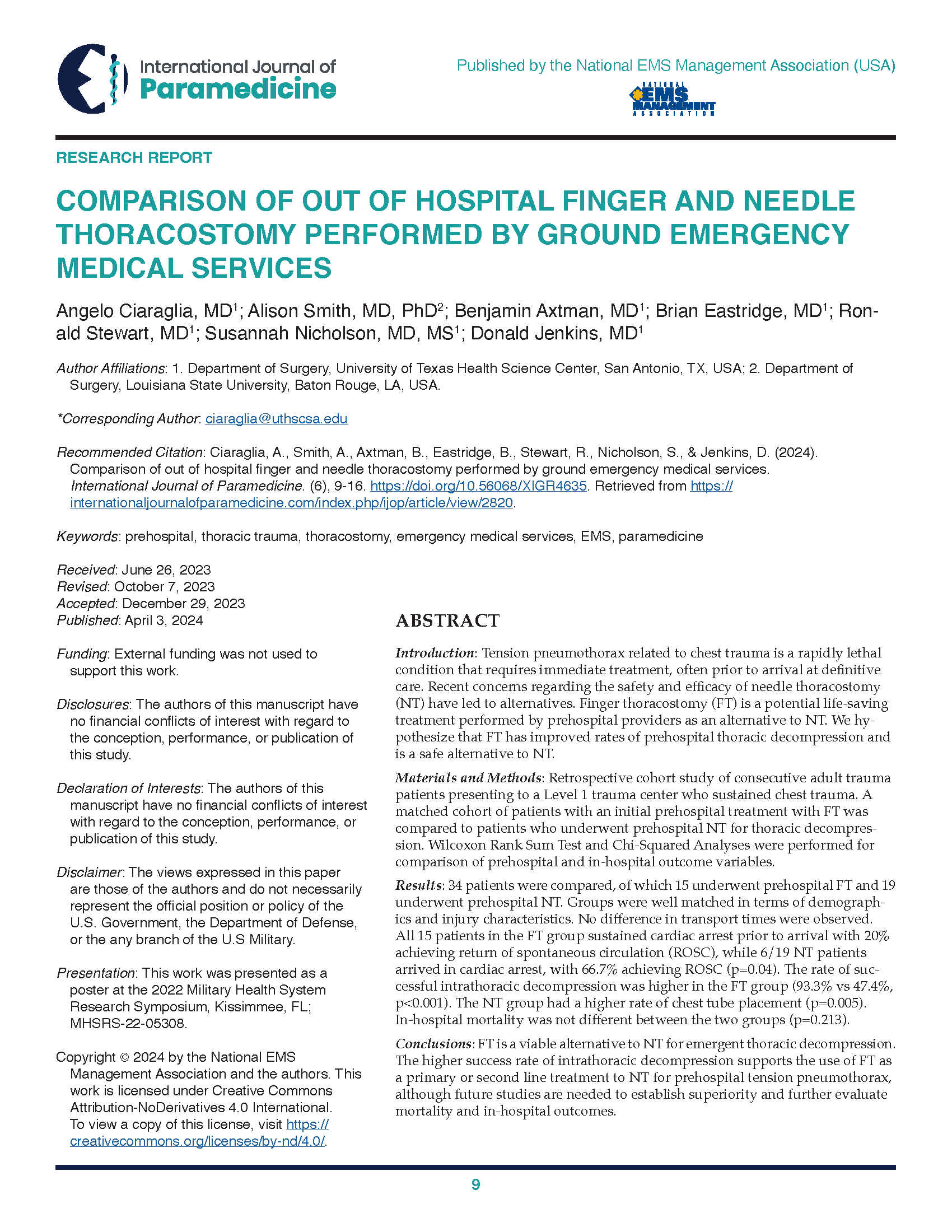Retrospective Matched Cohort Comparison of Prehospital Finger Thoracostomy and Needle Thoracostomy Performed by Ground Emergency Medical Services
Main Article Content
Abstract
Introduction: Tension pneumothorax related to chest trauma is a rapidly lethal condition that requires immediate treatment, often prior to arrival at definitive care. Recent concerns regarding the safety and efficacy of needle thoracostomy (NT) have led to alternatives. Finger thoracostomy (FT) is a potential life-saving treatment performed by prehospital providers as an alternative to NT. We hypothesize that FT has improved rates of prehospital thoracic decompression and is a safe alternative to NT.
Materials and Methods: Retrospective cohort study of consecutive adult trauma patients presenting to a Level 1 trauma center who sustained chest trauma. A matched cohort of patients who underwent prehospital FT was compared to patients who underwent prehospital NT for thoracic decompression. Wilcoxon Rank Sum Test and Chi-Squared Analyses were performed for comparison of prehospital and in-hospital outcome variables.
Results: 34 patients were compared, of which 15 underwent prehospital FT and 19 underwent prehospital needle thoracostomy NT. Groups were well matched in terms of demographics and injury characteristics. No difference in transport times were observed. All 15 patients in the FT group sustained cardiac arrest prior to arrival with 20% achieving return of spontaneous circulation (ROSC), while 6/19 NT patients arrived in cardiac arrest, with 66.7% achieving ROSC (p = 0.04). The rate of successful intrathoracic decompression was higher in the FT group (93.3% vs 47.4%, p<0.001). The NT group had a higher rate of chest tube placement (p=0.005). In-hospital mortality was not different between the two groups (p=0.213).
Conclusions: FT is a viable alternative to NT for emergent thoracic decompression. The higher success rate of intrathoracic decompression supports the use of FT as an alternative to NT for prehospital tension pneumothorax, although future studies are needed establish superiority and further evaluate mortality and in-hospital outcomes.
Article Details

This work is licensed under a Creative Commons Attribution-NoDerivatives 4.0 International License.
Publishing in IJOP allows authors to keep their copyright while giving IJOP unrestricted copyright permissions. Articles published in IJOP use Creative Common Attribution 4.0 International (CC BY-ND 4.0) licensing. This license requires that re-users give credit to the creator. It allows re-users to copy and distribute the material in any medium or format in unadapted form only, even for commercial purposes. Additional terms apply and can be accessed here.
Publishing in IJOP also allows authors to have contracts for non-exclusive distribution of the Journal's published version of the article, such as posting to an institutional repository or publication in a book, on the condition that the original publication in the original layout format in IJOP is retained and acknowledged.
We permit and encourage authors to post the articles they published in IJOP on their affiliated websites. This helps share the information, encourages citation in other works, and promotes scholarly discourse in the spirit of open access.
References
Axtman BC, Stewart KE, Robbins JM, et al. Prehospital needle thoracostomy: What are the indications and is a post-trauma center arrival chest tube required? Am J Surg. 2019;218(6):1138-1142.
Butler FK Jr., Holcomb JB, Shackelford S, et al. Management of Suspected Tension Pneumothorax in Tactical Combat Casualty Care: TCCC Guidelines Change 17-02. J Spec Oper Med. 18(2):19-35.
Chesters A DG, Wilson A. Four years of pre-hospital simple thoracostomy performed by a physician-paramedic helicopter emergency medical service team: a description and review of practice. Dent Traumatol. 2016;18:124–128.
Dickson RL, Gleisberg G, Aiken M, et al. Emergency Medical Services Simple Thoracostomy for Traumatic Cardiac Arrest: Postimplementation Experience in a Ground-based Suburban/Rural Emergency Medical Services Agency. J Emerg Med. 2018;55(3):366-371.
Evans CC, Petersen A, Meier EN, Buick JE, Schreiber M, Kannas D, Austin MA; Resuscitation Outcomes Consortium Investigators. Prehospital traumatic cardiac arrest: Management and outcomes from the resuscitation outcomes consortium epistry-trauma and PROPHET registries. J Trauma Acute Care Surg. 2016 Aug;81(2):285-93.
Hannon L, St Clair T, Smith K, et al. Finger thoracostomy in patients with chest trauma performed by paramedics on a helicopter emergency medical service. Emerg Med Australas. 2020;32(4):650-656.
Kaserer A, Stein P, Simmen HP, Spahn DR, Neuhaus V. Failure rate of prehospital chest decompression after severe thoracic trauma. Am J Emerg Med. 2017;35(3):469-474.
Laan DV, Vu TD, Thiels CA, et al. Chest wall thickness and decompression failure: A systematic review and meta-analysis comparing anatomic locations in needle thoracostomy. Injury. 2016;47(4):797-804.
Lesperance RN, Carroll CM, Aden JK, Young JB, Nunez TC. Failure Rate of Prehospital Needle Decompression for Tension Pneumothorax in Trauma Patients. Am Surg. 2018;84(11):1750-1755.
Martin M, Satterly S, Inaba K, Blair K. Does needle thoracostomy provide adequate and effective decompression of tension pneumothorax? J Trauma Acute Care Surg. 2012;73(6):1412-1417.
Massarutti D, Trillo G, Berlot G, et al. Simple thoracostomy in prehospital trauma management is safe and effective: a 2-year experience by helicopter emergency medical crews. Eur J Emerg Med. 2006;13(5):276-280.
Robitaille-Fortin M, Norman S, Archer T, Mercier E. Prehospital Decompression of Pneumothorax: A Systematic Review of Recent Evidence. Prehosp Disaster Med. 2021;36(4):450-459.
Wernick B, Hon HH, Mubang RN, et al. Complications of needle thoracostomy: A comprehensive clinical review. Int J Crit Illn Inj Sci. 2015;5(3):160-169.
Zengerink I, Brink PR, Laupland KB, Raber EL, Zygun D, Kortbeek JB. Needle thoracostomy in the treatment of a tension pneumothorax in trauma patients: what size needle? J Trauma Acute Care Surg. 2008;64(1):111-114.

